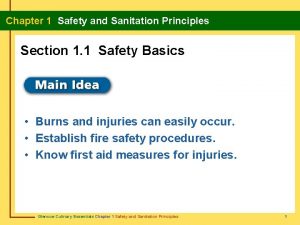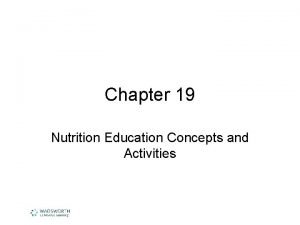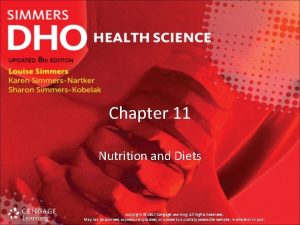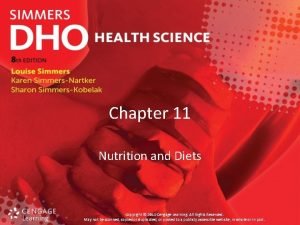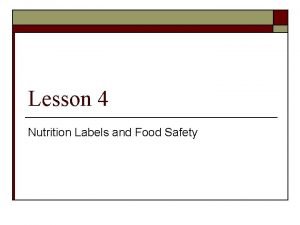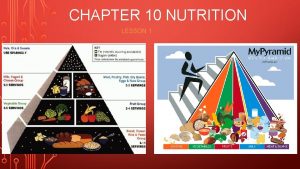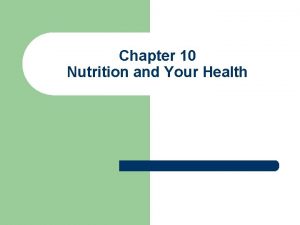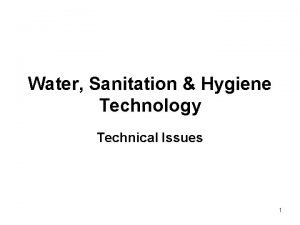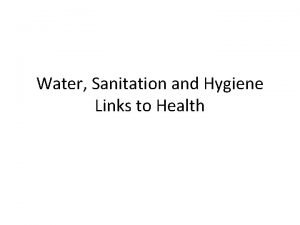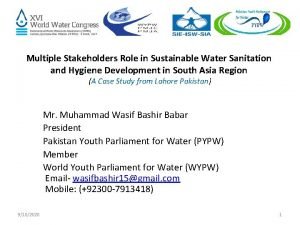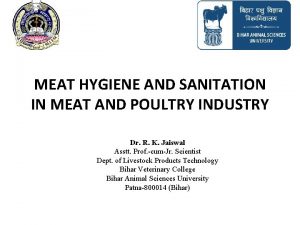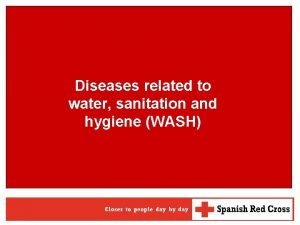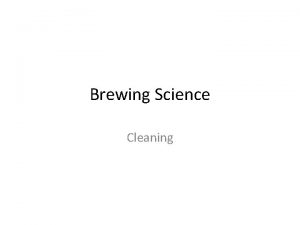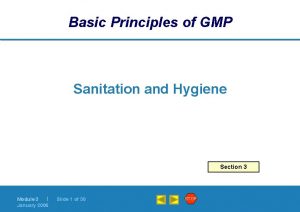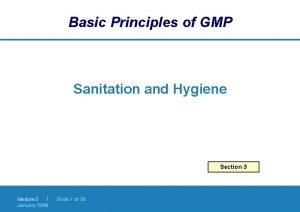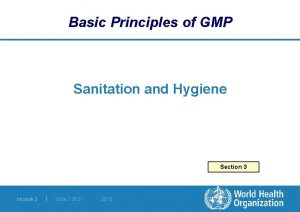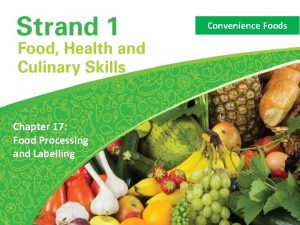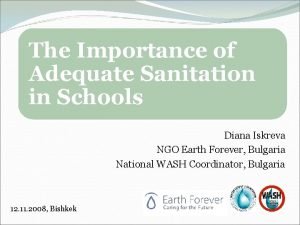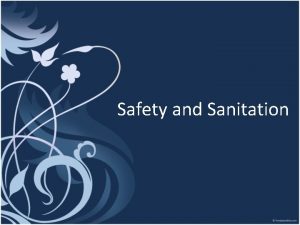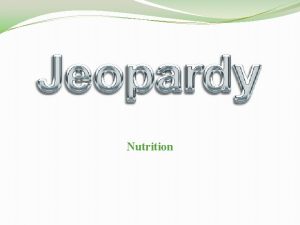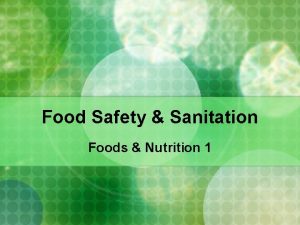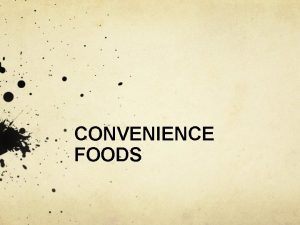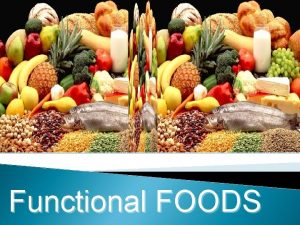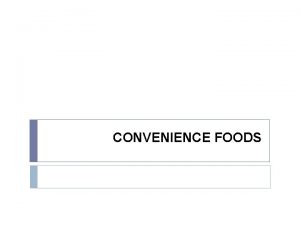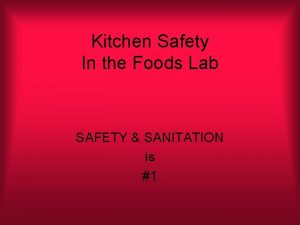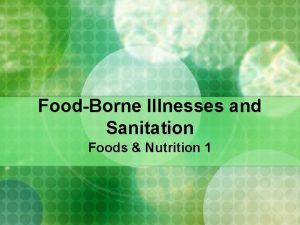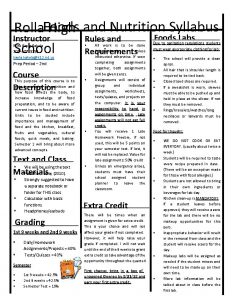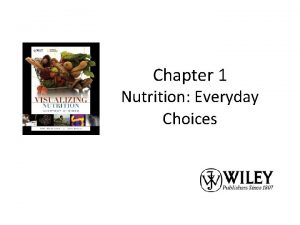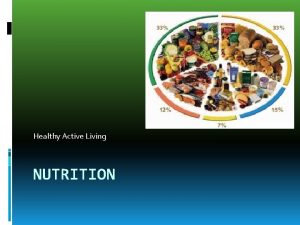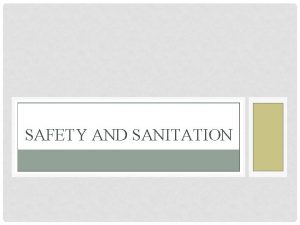Safety and Sanitation Foods and Nutrition Define terms





















- Slides: 21

Safety and Sanitation Foods and Nutrition

Define terms related to safety and sanitation 1. bacteria - single celled microorganisms that live in soil, water, and the bodies of plants and animals. 2. botulism - a food-borne illness, caused by eating food containing the spore-forming bacteria clostridium botulinum, that paralyzes the muscles and can easily cause death. This form of food poisoning is often caused by improper home canning. 3. canning - the process of preserving food by heating and sealing it in airtight containers for storage. 4. cross contamination - the transfer of harmful bacterial from one food to another food. 5. food-borne illness - a disease transmitted by food. 6. Heimlich maneuver - procedure that removes food or other obstacles form a choking person’s airway.

7. hygiene - practices that promote good health and prevention of disease, such as cleanliness and maintenance of skin, hair and nails. 8. irradiation - a commercial food preservation method that exposes food to gamma rays to increase shelf life and kill harmful microorganisms. 9. safety - the condition of being secure from threat of danger, harm or loss. 10. salmonella - a disease found in raw and undercooked eggs, poultry, meat, fish, and unpasteurized milk. 11. sanitation - maintaining a clean condition in order to promote hygiene and prevent disease. 12. staphylococcus - a pathogenic bacterium that resembles tiny circles in the shape of grapes. It can be found in the mouth, eyes, ears, and sinuses. 13. trichinosis - infestation with or disease caused by trichinae and marked especially by muscular pain and fever.

Describe food preparation, preservation, serving and storage techniques that prevent food poisoning All the guidelines for keeping food safe to eat can be summed up in four basic steps: 1. Clean (kitchen and self) • • Wash hands for 20 seconds with soap and warm water before starting to work with food. Keep hair tied back and avoid touching it. Cover an open sore or cut with rubber gloves. Cover coughs and sneezes and wash hands immediately. Wash hands thoroughly after handling raw meat. Use paper towels to clean raw meat juices, throw paper away and clean area. Wash dish cloths and sponges daily.

2. Separate (to prevent cross contamination) • Put raw meat in plastic bags before placing them in your shopping cart. • Store raw meat in a separate area of the refrigerator. • Don’t taste and cook with the same spoon. • Never use the same utensils, cutting board, etc. after using on raw meat. • Have a separate towel for wiping hands and dishes. • Never taste food that looks or smells questionable.

3. Cook • Keep hot foods hot (above 140 degrees F) • Meat such as steak and roast should have an internal temperature of 145 degrees F • Ground beef, meat loaf 160 degrees • Whole poultry 180 degrees • Poultry breast 170 degrees • Do not partially cook foods and then set aside or refrigerate to complete the cooking later. • Dispose of bulging, leaking or damaged cans. • Use only clean, fresh, unbroken eggs. • Do not eat raw cookie dough or taste partially cooked dishes containing meat, poultry, fish or eggs.

Differentiate between food-borne illnesses and the definitions Botulism • A food-borne illness, caused by eating food containing the spore-forming bacteria clostridium botulinum, that paralyzes the muscles and can easily cause death. This form of food poisoning is often cause by improper home canning. • Honey can contain spores of Clostridium botulinum and should not be fed to children less than 1 year. Honey is safe for persons 1 year of age and older. • The same bacterium that is used to produce Botox, Treatment administered in the medical setting is usually well tolerated. Occasionally there may be some side effects.

Campylobacteriosis • Generally spread by eating or drinking contaminated food or water. • Contact with infected people or animals • Will not readily grow in food. • Risk is greater with the consumption of raw or under cooked food of animal origin. • Household pets with diarrhea have often been shown to be the source of infection for many. • Irradiation (a commercial food preservation method that exposes food to gamma rays to increase shelf life and kill harmful microorganisms) readily destroys it and greatly reduce the incidence on poultry.

E. Coli infection short for Escherichia coli • Germ that causes severe cramps and bloody diarrhea. • More common during the summer months and in northern states. • The most common way to get this infection is by eating undercooked hamburgers.

Listeriosis • Infection is rare, but when it does occur it most frequently affects pregnant women in their last trimester, newborns, children and adults whose immunity is weakened by diseases such as cancer or AIDS. • Can be transmitted through soil and water. A person can also ingest listeria by eating certain foods, such as deli meats and cold cuts, softripened cheese, milk, undercooked chicken, uncooked hot dogs, shellfish, and coleslaw made from contaminated cabbage.

Perfringens Poisoning • Clostridium perfringens is one of the most commonly reported foodborne illnesses. Sometimes it is called the "food service germ" because food served in quantity and left for long periods on a steam table or at room temperature can cause this illness. • Intense abdominal pain and diarrhea begin 8 to 22 hours after eating foods that contain these bacteria. The illness is usually over within 24 hours but less severe symptoms may last longer for some people – especially very young or older people. • Many times, people confuse this foodborne illness with the "24 -Hour Flu. "

Salmonellosis • An infection with a bacteria called salmonella (a disease found in raw and undercooked eggs, poultry, meat, fish, and unpasteurized milk) • Contaminated foods usually look and smell normal. • Thorough cooking kills Salmonella. • Food may also become contaminated by the unwashed hands of an infected food handler, who forgot to wash his or her hands with soap after using the bathroom. • Reptiles are particularly likely to harbor Salmonella and people should always wash their hands immediately after handling a reptile, even if the reptile is healthy.

Staphylococcus • A pathogenic bacterium that resembles tiny circles in the shape of grapes. It can be found in the mouth, eyes, ears, and sinuses. • Typical contaminated foods include custard, cream-filled pastry, milk, processed meats, and fish. • Careful food preparation can prevent staphylococcal food poisoning. • Anyone who has a skin infection should not prepare food for others until the infection heals.

Trichinosis • Infestation with or disease caused by trichinae and marked especially by muscular pain and fever. • Caused by eating uncooked or poorly cooked meat from an animal that carries the parasite. • Most human infections result from pork, particularly in regions where pigs are fed uncooked meat scraps and garbage. • Rare in the United States.

State safety precautions to follow in the kitchen Explain basic first-aid procedures Preventing Chemical Poisoning • Keep all hazardous out of children’s reach. • Keep all hazardous products in their original containers. • Wash all fresh fruits and vegetables to remove pesticides and insecticides. v. In case of poisoning call the nearest poison control center immediately.

Preventing Cuts • • • Keep knives SHARP. Use knives properly. Don’t try to catch a falling knife. Wash and store knives separately. Never pick up broken glass with your bare hands. v. Cover wound with clean cloth and apply pressure. If minor clean with soap and water.

Preventing Burns and Fires • Use potholders not dish towels. • Turn pan handles inward. • Open pan lids away from you to prevent steam burns. • Never leave a pan of grease unattended. • Keep a fire extinguisher handy. v Immediately run cold water over a burn.

Preventing Falls • Use a steady step stool or ladder to reach high places. • Don’t walk on a wet floor. • Make sure rugs have a non skid backing. v. If you suspect a broken bone do not move the person. v. Make person comfortable. v. Do not give them anything to eat or drink.

Preventing Shock • Don’t touch plugs or switches with wet hands. • Don’t use lightweight extension cords with small appliances. • Don’t overload electrical outlets. • Don’t use damaged appliances. v Do not touch the person if they are connected to the power source. v Disconnect the appliance or turn off the power causing the shock. v Use a non-conducting material (rope, dry cloth, wooden pole) to pull the person away from the electrical source. v Call for help.

Preventing Choking • Chew food thoroughly before swallowing. • Avoid talking or laughing with food in your mouth. v Do the Heimlich maneuver (procedure that removes food or other obstacles from a choking person’s airway) if necessary. v Someone who can cough, breathe, or talk is not choking. v If the person looses consciousness, do not attempt the Heimlich. v Call for help.

 Chapter 1 safety and sanitation principles
Chapter 1 safety and sanitation principles Foods used in nutrition activities should be nutrient-dense
Foods used in nutrition activities should be nutrient-dense Chapter 11 nutrition and diet
Chapter 11 nutrition and diet Test chapter 11 nutrition and diets
Test chapter 11 nutrition and diets Polynomial classification
Polynomial classification Like terms
Like terms Datingoo
Datingoo Chapter 10 nutrition for health lesson 1 answer key
Chapter 10 nutrition for health lesson 1 answer key Chapter 10 lesson 4 nutrition labels and food safety
Chapter 10 lesson 4 nutrition labels and food safety Sanitation and hygiene
Sanitation and hygiene Sanitation and hygiene
Sanitation and hygiene Stakeholders in water and sanitation
Stakeholders in water and sanitation Poultry hygiene and sanitation
Poultry hygiene and sanitation Sanitation and hygiene
Sanitation and hygiene Cleaning and sanitation manual for breweries
Cleaning and sanitation manual for breweries Gmp sanitation and hygiene
Gmp sanitation and hygiene Gmp sanitation and hygiene
Gmp sanitation and hygiene Basic principles of personal hygiene
Basic principles of personal hygiene Compendium of sanitation systems and technologies
Compendium of sanitation systems and technologies Types of food convenience
Types of food convenience Concept school
Concept school Delvic sanitation initiatives
Delvic sanitation initiatives
